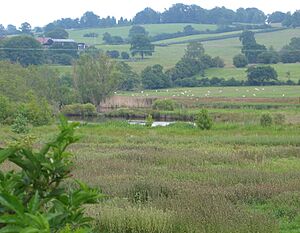Quoisley Meres facts for kids
| Site of Special Scientific Interest | |

Quoisley Big Mere
|
|
| Area of Search | Cheshire |
|---|---|
| Coordinates | 53°00′18″N 2°40′26″W / 53.005°N 2.674°W |
| Interest | Biological |
| Area | 28.25 ha (69.8 acres) |
| Notification | 1963 |
The Quoisley Meres are two special lakes in Cheshire, England. They are called Quoisley Big Mere and Quoisley Little Mere]]. You can find them near the village of Marbury. These lakes are very important for nature. They are home to many different plants and animals.
The water in these lakes is full of nutrients. This helps many plants grow. The areas around the lakes, like the reed beds and damp grassland, are also very important. Because of their special nature, the Quoisley Meres are a Site of Special Scientific Interest (SSSI). They are also part of a bigger area called the Midland Meres and Mosses Ramsar site. This means they are recognized as important wetlands around the world.
These meres are a great place for small creatures called invertebrates and many kinds of birds. Over 100 different types of plants grow here. Some of these plants, like tufted-sedge, marsh fern, and meadow thistle, are quite rare in Cheshire. In 2009, a group called Natural England said the site needed some help to stay healthy.
Contents
Where Are the Quoisley Meres?
The Quoisley Meres are located on the Cheshire Plain. This is a flat area of land. They are close to the border with Shropshire. The lakes are about 75 meters above sea level.
How These Lakes Were Formed
Most lakes in this area, including the Quoisley Meres, were made a very long time ago. They formed at the end of the last ice age. This was about ten to fifteen thousand years ago. As the ice melted, big chunks of ice were left behind. When these ice chunks melted, they left holes in the ground. These holes then filled with water, creating the lakes we see today. They are sometimes called "kettle holes."
The meres are about three-quarters of a mile west of Marbury village. The closest town is Whitchurch, which is about two and a half miles to the south. Quoisley Big Mere is the larger lake. Quoisley Little Mere is the smaller one. A thin line of trees, called Holly Rough, is just north of Little Mere. The area that collects water for the meres is about 136 hectares.
Special Protected Areas
The Quoisley Meres area was named a Site of Special Scientific Interest (SSSI) in 1963. This SSSI covers about 28 hectares. It includes both lakes, their edges, and some of the grassy fields around them. The Holly Rough woodland is not part of the SSSI.
In 1994, the meres were also named Wetlands of International Importance. This was part of the Midland Meres and Mosses Ramsar site. This means they are very important wetlands on a global scale. The meres are also in a special area called the Wirswall/Marbury/Combermere Area of Special County Value.
Plants and Animals of Quoisley Meres
The two lakes have open water that is rich in nutrients. This helps many water plants grow. The main plants in the water are water lilies. Big Mere has both white and yellow water lilies. Little Mere mostly has white water lilies.
Life in the Water and Reeds
Both lakes are surrounded by thick reed beds. These are areas where tall grass-like plants grow in the water. Big Mere has many different types of plants in its reed beds. These include common club-rush, greater pond-sedge, lesser reedmace, and tufted-sedge. The tufted-sedge is rare in Cheshire. Big Mere also has a thin border of alder trees around it.
The SSSI also includes damp grassland between and around the two lakes. This grassland has many different plant species. Some of these are brown sedge and purple small-reed. You can also find marsh fern and meadow thistle here. These two plants are not often found in Cheshire. In total, 108 different plant species have been found at the site.
Amazing Wildlife at the Meres
The lakes are home to many water-living invertebrates. These are small creatures without backbones. There are many beetles and bugs, including some rare kinds. There are not many fish in the lakes, especially in Little Mere. The main fish is roach. You can also find some eels, pike, tench, and trout.
The Quoisley Meres are also an important place for birds. Birds like gadwall, garganey, and ruddy ducks have been seen here.
Looking After Quoisley Meres
The Quoisley Meres are on private land. This means that public access to the site is limited. There is a public footpath from Wirswall Road. This path crosses a field to the east of Quoisley Little Mere. You can see Big Mere from the track that goes from Wirswall Road to Mere Farm. Fishing is not allowed unless you are the owner.
In 2009, Natural England checked the health of the site. They found that most of the area, about 92.5%, was not in a good condition. Only a small part, about 7.6%, was stable. This was due to several reasons. These included problems with drainage and water levels. Poor ditch care and not controlling pests and weeds were also issues. Water pollution and dirt building up from farm water running off the land also caused problems. Not enough grazing in some grassland areas was also a concern.



